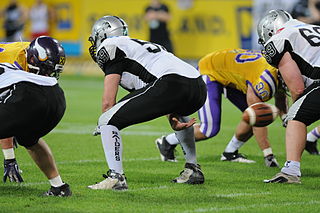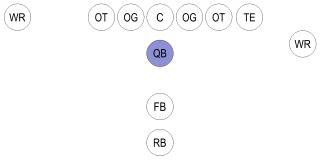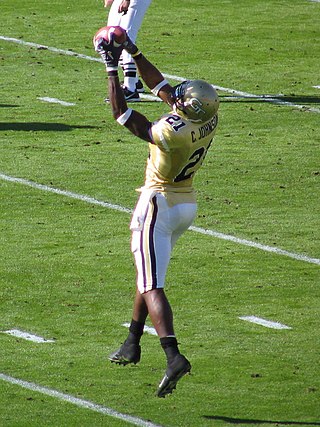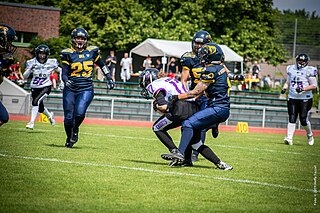Related Research Articles
In gridiron football, not all players on offense are entitled to receive a forward pass: only an eligible pass receiver may legally catch a forward pass, and only an eligible receiver may advance beyond the neutral zone if a forward pass crosses into the neutral zone. If the pass is received by a non-eligible receiver, it is "illegal touching". If an ineligible receiver is beyond the neutral zone when a forward pass crossing the neutral zone is thrown, a foul of "ineligible receiver downfield" is called. Each league has slightly different rules regarding who is considered an eligible receiver.

A snap is the backward passing of the ball in gridiron football at the start of play from scrimmage.

The quarterback, colloquially known as the "signal caller", is a position in gridiron football. Quarterbacks are members of the offensive platoon and mostly line up directly behind the offensive line. In modern American football, the quarterback is usually considered the leader of the offense, and is often responsible for calling the play in the huddle. The quarterback also touches the ball on almost every offensive play, and is almost always the offensive player that throws forward passes. When the QB is tackled behind the line of scrimmage, it is called a sack.

In gridiron football, a lineman is a player who specializes in play at the line of scrimmage. The linemen of the team currently in possession of the ball are the offensive line, while linemen on the opposing team are the defensive line. A number of NFL rules specifically address restrictions and requirements for the offensive line, whose job is to help protect the quarterback from getting sacked for a loss, or worse, fumbling. The defensive line is covered by the same rules that apply to all defensive players. Linemen are usually the largest players on the field in both height and weight, since their positions usually require less running and more strength than skill positions.

A wide receiver (WR), also referred to as a wideout, historically known as a split end (SE) or flanker (FL), is an eligible receiver in gridiron football. A key skill position of the offense, WR gets its name from the player being split out "wide", farthest away from the rest of the offensive formation.

American and Canadian football are gridiron codes of football that are very similar; both have their origins in rugby football, but some key differences exist between the two codes.
Strategy forms a major part of American football. Both teams plan many aspects of their plays (offense) and response to plays (defense), such as what formations they take, who they put on the field, and the roles and instructions each player are given. Throughout a game, each team adapts to the other's apparent strengths and weaknesses, trying various approaches to outmaneuver or overpower their opponent in order to win the game.

Gameplay in American football consists of a series of downs, individual plays of short duration, outside of which the ball is dead or not in play. These can be plays from scrimmage – passes, runs, punts, or field goal attempts – or free kicks such as kickoffs and fair catch kicks. Substitutions can be made between downs, which allows for a great deal of specialization as coaches choose the players best suited for each particular situation. During a play, each team should have no more than 11 players on the field, and each of them has specific tasks assigned for that specific play.

In gridiron football, an official is a person who has responsibility in enforcing the rules and maintaining the order of the game.
A formation in football refers to the position players line up in before the start of a down. There are both offensive and defensive formations and there are many formations in both categories. Sometimes, formations are referred to as packages.
A trick play, also known as a gadget play, gimmick play or trickeration, is a play in gridiron football that uses deception and unorthodox tactics to fool the opposing team. A trick play is often risky, offering the potential for a large gain or a touchdown if it is successful, but with the chance of a significant loss of yards or a turnover if not. Trick plays are rarely used not only because of the riskiness, but also to maintain the element of surprise for when they are used.
The triple option is an American football play used to offer several ways to move the football forward on the field of play. The triple option is based on the option run, but uses three players who might run with the ball instead of the two used in a standard option run.
In American football, a play is a close-to-the-ground plan of action or strategy used to move the ball down the field. A play begins at either the snap from the center or at kickoff. Most commonly, plays occur at the snap during a down. These plays range from basic to very intricate. Football players keep a record of these plays in a playbook.
In gridiron football, intentional grounding is a violation of the rules where "a passer...throws a forward pass without a realistic chance of completion." This typically happens when a quarterback about to be sacked passes the ball toward an area of the field with no eligible receiver. Without this rule, the quarterback could almost always avoid a sack by intentionally throwing an incomplete pass ; instead, the penalty of intentional grounding effectively continues play as if the defense had succeeded in sacking the quarterback.
An official in Canadian football is a person who has responsibility in enforcing the rules and maintaining the order of the game, like their counterparts in the American game. In the Canadian Football League, seven officials operate on the field. Lower levels of play up to the university level use less than the standard seven.
The A-11 offense is an offensive scheme that has been used in some levels of amateur American football. In this offense, a loophole in the rules governing kicking formations is used to disguise which offensive players would be eligible to receive a pass for any given play. It was designed by Kurt Bryan and Steve Humphries of Piedmont High School in California.
The following terms are used in American football, both conventional and indoor. Some of these terms are also in use in Canadian football; for a list of terms unique to that code, see Glossary of Canadian football.

The run-pass option (RPO) is a type of designed option play in gridiron football in which the offensive team has the ability to either rush or pass the ball depending on the alignment and actions of defensive team. Like the standard read-option, the quarterback is responsible for viewing the actions of a particular defender and makes a decision to hand the ball off to their running back depending on how that defender chooses to act after the snap of the ball. However, unlike the read-option, the quarterback is responsible for making a decision regarding whether or not to throw a play-action pass to a receiver running a designed route, rather than simply the decision to keep the ball and run with it.
References
- 1 2 "NFL Rules Digest: Forward Pass". www.nfl.com. Archived from the original on 2018-03-22. Retrieved 2017-12-22.
- ↑ "Know Your Annoying Penalties: Ineligible Man Downfield". Team Speed Kills. Retrieved 2017-12-22.
- ↑ "What Does "Ineligible Receiver Downfield" Mean?". ThoughtCo. Retrieved 2017-12-22.
- ↑ "Illegal man downfield rule will be enforced 'as it's written' in 2016, NCAA officiating chief says". AL.com. Retrieved 2017-12-22.
- ↑ "Football Rules Committee approves proposals to enhance player safety". NCAA.com. 2016-02-11. Retrieved 2017-12-22.
- ↑ "NCAA Football: 2016 and 2017 Rules and Interpretations" (PDF). July 19, 2017. pp. 71–73.